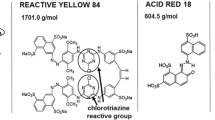Abstract
Comparative investigations of adsorption properties of chlorhexidine (CHX) on two cellulose fibers, bleached cotton and viscose, were studied in order to obtain dry gauzes covered with known amount of this antiseptic. Adsorption isotherm results carried out at 293 and 323 K can be described by Langmuir isotherm model, nevertheless, at high concentration correlation is better to Freundlich isotherm. Electrokinetic potential evolution with CHX concentration, shows that initial negative zeta potential of cotton and viscose diminish its absolute value as the concentration of the treatment increases; both fibers present an isoelectric point at high concentration of CHX that is 0.3 mM for viscose and 0.8 mM for cotton. Electrostatic interactions between cationic groups of CHX and carboxylic acid groups of the fibers could explain adsorption at low concentration, but when it is higher than these values, possible hydrogen bonding between the amine groups of CHX and hydroxyl groups of cellulose could explain increasing adsorption when it is hindered by electrostatic repulsion as it is predicted by Freundlich model, that describes heterogeneous surface and multilayer adsorption. Adsorption kinetics isotherms reveal that the process is quick with t 1/2 values of 5.4 min for cotton and 2.8 min for viscose. Differences in adsorption behaviour between the two fibers could be attributed to structural differences as we have observed from estimation of CI index based on FTIR spectra. Values obtained 1.6 for viscose and 2.2 for cotton could explain that the amount of CHX adsorbed on viscose is higher than it is on cotton. Finally desorption experiments performed with 0.01 M of NaCl solution at room temperature and pH 6 reveals the possibility of therapeutical application of these fibers although further investigations must be done to optimize the process.












Similar content being viewed by others
References
Chibowski E, Espinosa-Jiménez M, Ontiveros-Ortega A, Giménez-Martín E (1998) Surface free energy, adsorption and zeta potential in leacril/tannic acid system. Langmuir 14:5237–5244
Davidson GF (1948) The acidic properties of cotton cellulose and derived oxycelluloses. Part II. The absorption of methylene blue. J Text Inst 39:65–86
Espinosa-Jiménez M, Giménez-Martín E, Ontiveros Ortega A (1997) Adsorption of N-cetylpyridinium chloride on leacril fibers: kinetics and thermodynamics. Textile res J 67(9):677–683
Espinosa-Jimenez M, Ontiveros-Ortega A, Perea-Carpio R, Giménez-Martín E (2002) Interfacial chemistry of fabric surfaces, encyclopedia of surface and colloid science. Marcel Dekker Inc, New York, pp 2770–2786
Fras-Zemljic L, Stenius P, Stana-Kleinschek K, Ribitsch V, Dolecek V (2004) Determination of dissociable groups in natural and regenerated cellulose fibers by different tritiation methods. J Appl Polym Sci 92:3186
Fras-Zemljic L, Persin Z, Steinius P, Stana-Kleinsschek K (2008) Carboxyl groups in pre-treated regenerated cellulose fibres. Cellulose 15:681–690
Giménez-Martín E, Espinosa-Jiménez M (2005) Influence of tannic acid in Leacril/Rhodamina B system: thermodynamics aspects. Colloid Surfaces A 270–271:93–101
Giménez-Martín E, Ontiveros-Ortega A, Espinosa-Jiménez M, Perea-Carpio R (2007) Electrokinetic effect and surface free energy behaviour in adsorption of a reactive dye onto Leacril pretreated with polyethyleneimide ion. J Colloid Interface Sci 311:394–399
Ibbett R, Taylor J, Christian Schuster K, Cox M (2008) Interpretation of relaxation and swelling phenomena in lyocell regenerated cellulosic fibers and textile associated with the uptake of solutions of sodium hydroxide. Cellulose 15:393–406
Jacobasch HJ, Bauösk G, Schurz J (1985) Problems and results of zeta-potential measurements on fibers. Colloid Polym Sci 263:3–24
Klemm D, Philipp B, Heinze T (1998) Comprenhensive cellulose chemistry. Wiley_VCH Verlag, Winheim, pp 9–12
Krässig HA (1984) Struktur und reaktivität von Cellulosafasesn. Das Papier 38:571
Krässig HA (1992) Cellulose, structure, accessibility and reactivity. Gordon & Breach, New York
Lyklema J (1995) Fundamentals of interface and colloid science, vol I. Academic Press, London
Martínez de las Marías P (1976) Química y Física de las fibras textiles, editorial Alhambra, Madrid
Morton P (1996) Oral hygiene products and practice, products components: therapeutic agents. Marcel Dekker Inc, New York, pp 219–329
Perineau F, Gaset A (1981) Etude de l’adsorption de surfactants ioniques et non ioniques sur de la matière végétale carbonisée. Can J Chem 59(1):19–26
Peters RH (1975) Textile chemistry, vol III. Elsevier Scientific Publishing Company, New York, pp 149–172
Reishl M, Stana-Kleinsschek K, Ribitsch V (2006) Electrokinetic investigations of oriented cellulose polymers. Macromol Symp 244:31–47
Ribitsch V, Stana-Kleinschek K, Kreze T, Strnad S (2001) The significance of surface charge and structure on the accessibility of cellulose fibres. Macromol Mater Eng 286:648
Sang Youn Oh, Dong Il Yoo, Younsook Shin, Gon Seo (2005) FTIR analysis of cellulose treated with sodium hydroxide and carbon dioxide. Carbohydr Res 340:417–428
Stana-Kleinsschek K, Kreze T, Ribitsch V, Simona S (2001) Reactivity and electrokinetical properties of different types of regenerated cellulose fibres. Colloid Surfaces 195:275–284
Stana-Kleinsschek K, Ribitsch V, Kreze T, Fras L (2002) Determination of the adsorption character of cellulose fibers using surface tension and surface charge. Mat Res Innovat 6:13
Tyrone LV (1997) Textile processing and properties. Elsevier, Amsterdam, pp 63–71
Van de Ven TGM, Alince B, (1997) Porosity of swollen pulp fibers evaluated by polymer adsorption. In: Baker CF (ed) Fundamentals of papermaking transations of the 11th reseacrch symposium held at cambridge, Pira International, Leatherhead, UK, p 771
Wägberg L, Hägglund R (2001) Kinetics and polyelectrolyte adsorption on cellulose fibers. Langmuir 17:1096–1103
Acknowledgments
We express our gratitude to DENTAID S.A for providing us with chlorhexidine digluconate used in this project and all the necessary related information. We express our gratitude to DGICYT (Dirección General de Investigación Científica y Técnica), Spain, Project No.FIS2005-06860-C02-02.
Author information
Authors and Affiliations
Corresponding author
Rights and permissions
About this article
Cite this article
Giménez-Martín, E., López-Andrade, M., Ontiveros-Ortega, A. et al. Adsorption of chlorhexidine onto cellulosic fibers. Cellulose 16, 467–479 (2009). https://doi.org/10.1007/s10570-009-9281-5
Received:
Accepted:
Published:
Issue Date:
DOI: https://doi.org/10.1007/s10570-009-9281-5




